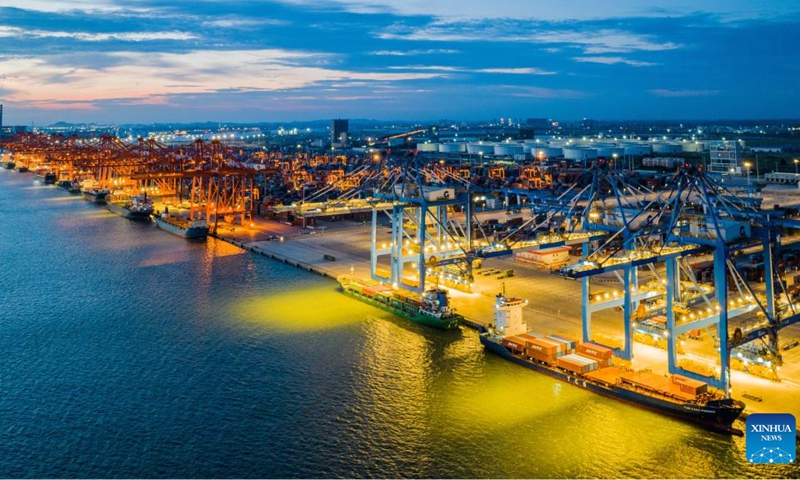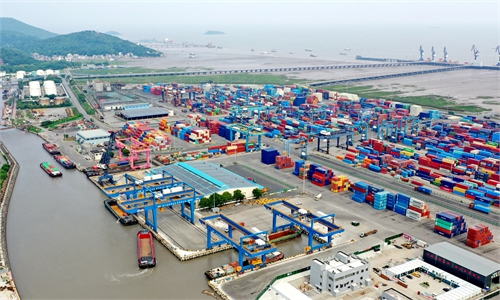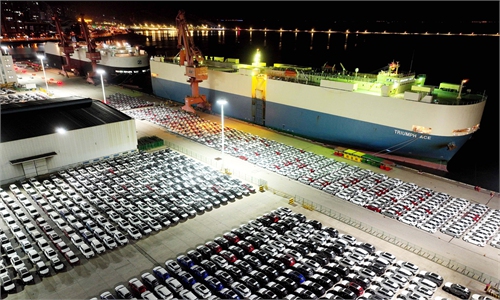China ‘confident’ of foreign trade growth in H2, as more support measures rolled out

Aerial photo taken on Sept. 13, 2022 shows the night view of Qinzhou Port in Qinzhou, south China's Guangxi Zhuang Autonomous Region. After 30 years of development, the Qinzhou Port has been constructed into an international sea-rail intermodal container terminal, operating more than 60 container service routes with a connection to more than 200 ports in over 100 countries and regions around the world.(Photo: Xinhua)
Despite headwinds from weakening overseas demand, China expects foreign trade to grow in the second half of the year, boosting the nation's economic recovery, Wang Shouwen, vice minister of commerce, told a press conference on Tuesday, vowing more support measures amid lingering challenges of global inflation, COVID-19 and geopolitical tensions.
The nation's foreign trade is stabilizing due to its complete and resilient supply chains and support measures, experts said, noting that trade will keep growing for the rest of the year as more support policies are rolled out.
Slowing overseas demand is now the largest source of uncertainty facing China's trade, as major economies, including the US and the Europe. face challenges, Wang said at a press conference on Tuesday.
The development of foreign trade faces an increasingly complex environment. Thus, it's necessary to launch a new round of policies to ease pressure on businesses and stabilize foreign trade, Wang stressed.
The Ministry of Commerce (MOFCOM) on Tuesday announced a series of support measures, such as joining forces with local governments and other departments to ensure support for enterprises in epidemic prevention, energy supplies, logistics and other aspects.
The MOFCOM will help companies to attend exhibitions, enhance support for cross-border e-commerce and further improve the logistics system.
Zhou Maohua, a macroeconomist at Everbright Bank, told the Global Times on Tuesday that the slowdown in global demand and volatile currency markets may affect China's exports and thus disrupt its industrial production.
Given the complex environment, China's policies must address both supply and demand, while offering support for some enterprises, reducing industrial costs and optimizing the foreign trade structure, Zhou said.
"China also needs to continuously improve the software and hardware infrastructure such as international payments and settlements and steadily expand the yuan's use in foreign trade settlements," Zhou said.
Amid the complex situation, the World Bank lowered its forecast for China's GDP growth to 2.8 percent in 2022, compared with 8.1 per cent last year, while its prediction in April was between 4 and 5 percent for this year.
Despite external challenges, China's foreign trade held steady from January to August, thanks to policy support and complete supply chains, rising 10.1 percent year-on-year to 27.3 trillion yuan ($3.8 trillion). The figure demonstrated the strong resilience and vitality of the nation's trading sector, Wang noted.
Vehicle exports increased 57.6 percent and those of solar cell exports soared 92.6 percent, reflecting a solid foundation and the competitiveness of China's foreign trade industries, Wang said. The newly signed Regional Comprehensive Economic Partnership (RCEP) played an important role in boosting trade. The RCEP is the largest free trade deal across the world, covering about 30 percent of the world's population and GDP.
Though China's foreign trade activity slowed in August, exports to other RCEP members increased by 23 percent, 11.2 percentage points higher than the nation's overall trade growth in the month, Wang noted.
The resilient trade growth has helped the performance of industrial enterprises.
From January to August, operating income of industrial enterprises above designated size increased by 8.4 percent year-on-year, continuing the trend of rapid growth, data from the National Bureau of Statistics showed on Tuesday.
Rising demand for heating equipment driven by Europe's energy crisis and green energy transformation boosted the manufacturing of lithium-ion batteries, photovoltaic equipment and air conditioners in China, driving up the profits of the electrical machinery industry from January to August by 36.7 percent.
In the second half of the year, the government's policies to stabilize foreign trade and investment will yield results and promote trade growth, Li Chunding, head of the Economics and Trade Department of the College of Economics and Management at China Agricultural University, told the Global Times on Tuesday.
"China's continuous promotion of the construction of free trade zones and development of cross-border e-commerce will provide momentum for the sustainable development of trade," Li said.


